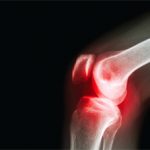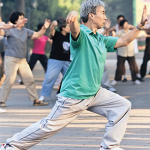Examining how exercise may potentially decrease RA disease activity is a relatively new focus. A randomized controlled trial of the safety of long-term, high-intensity aerobic exercise demonstrated improvements in disease activity (DAS lowered by 0.14).38 However, in the aggregrate, a Cochrane review deemed the effects of land-based aerobic and strength programs on RA disease activity not significant (ES= 0.16 [-0.39, 0.06]).5 Many pharmacological interventions prefer to express disease activity outcomes as a percentage of study participants that reach remission or have low or active disease, making comparisons between the two fields difficult.24 Attenuating inflammatory markers and increasing pain tolerance are believed effects of exercise that can influence disease activity.11 However, it is hard to determine what intensity, duration or frequency is needed for a patient, because the scientific evidence is scarce.
Functional Ability & Exercise Interventions
Functional ability is often evaluated with a Health Assessment Questionnaire (HAQ), and a decrease of <0.22 is considered clinically meaningful.39 The HAQ has been used as a primary outcome to evaluate the benefits of exercise interventions for several years. In a review of nine RCTs, the effects of aerobic exercise on HAQ was defined as a standardized mean difference of 0.24 ([95% CI 0.10, 0.38], P=0.001; I2=29%).40 Marcora et al found progressive resistance strength training performed, on average, 2.5 times a week over 12 weeks resulted in increased lean muscle leg mass (by 839 grams, P<0.001) and improved modified HAQ scores by -0.25.41 However, another study found little to no effect on daily functioning (multi-dimensional HAQ) following an exercise intervention.18
Rheumatoid Cachexia
Rheumatoid cachexia (RC), a feature of RA, is a down-regulated state of anabolic muscle growth.42 Suspected culprits are malnutrition, suppressed IGF regulation, circulating pro-inflammatory cytokines (such as CRP and IL-6) and inadequate physical activity.43,44 RC may be present in as many of 53% of adults with RA.45
Traditionally, BMI has been the focus of CVD risk in RA patients, because a high BMI is associated with increased relative risk of CVD in the presence of obesity (RR=1.16; 95% CI 1.03, 1.29).46 A low BMI can also increase the risk of CVD events (hazard ratio [HR] 3.34, 95% confidence interval [95% CI] 2.23–4.99).47 Many exercise interventions were designed to normalize the BMI of RA subjects. However, BMI may not be a suitable measure of RC; among women with RA, 88.9% had a normal BMI.48 Thus, lean body mass may be a more suitable measure to use. It is unclear how the presence of RC affects the risk of CVD in RA, because prospective studies are lacking.49


